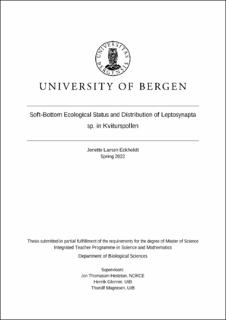| dc.description.abstract | This thesis aims to give an overview of the current ecological status of Kviturspollen by using CTD data and soft-bottom samples to evaluate the conditions, and results from past surveys to evaluate any improvement or deterioration. Kviturspollen is a land-locked fjord located approximately 14 km south of Bergen, and has been a part of the local recipient surveys in 1990, 2013 and 2014. Due to a shallow sill between Raunefjorden and Kviturspollen, as well as a canal which changed the main current from the neighboring land-locked fjord away from Kviturspollen, the oxygen levels through time have been very low and periodically absent. Kviturspollen is a land-locked fjord with two eelgrass meadows, and therefore has a unique and important ecosystem to preserve. In this survey, eight stations were chosen in Kviturspollen and one was chosen in Raunefjorden for reference. CTD-measurements were taken in three main areas: the innermost and the outer part of Kviturspollen, as well as in Raunefjorden. All samples were collected between May 2021, and February 2022. At some of the stations, additional samples were taken to more accurately map the distribution and density of the holothurian Leptosynapta sp. Comparing results from past surveys with the results from this, shows that Kviturspollen has undergone slight improvements in relations to diversity and sensitivity of the species. The salinity levels in the land-locked fjord were good, and the oxygen levels were high throughout all out measurements, although the sediment in some of the stations contained H2S. The bottom fauna samples presented great variations in diversity and sensitivity between the stations, and nearby stations often showed low similarity. In Kviturspollen, the diversity and sensitivity were highest at station 3 and 6, probably because of low amounts of sedimentation and high exposure to the current. Station 1 and 2 were completely lifeless, with sediment smelling of H2S. This is likely because the previous surveys have shown that the bottom water in the deepest basins frequently have been anoxic in the past. The stations are also located outside the current in an area with high sedimentation. The density of L. sp. was highest in the areas with high sedimentation and no H2S. The ecological status of Kviturspollen appears to have improved slightly, with a higher number of individuals found per m2, higher NQI1 values, and no anoxic bottom water measured. | |
